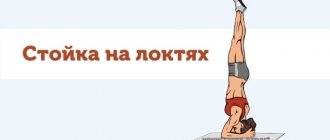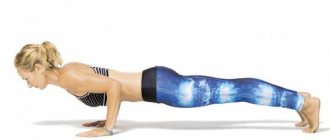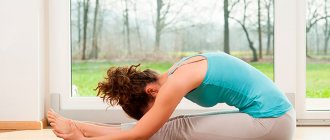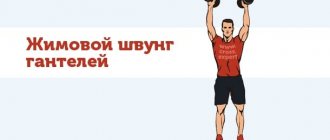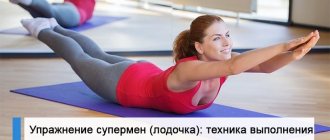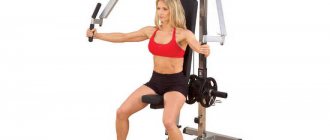Vrikshasana translated from Sanskrit means “tree pose.” This asana is suitable for beginner practitioners. The pose stretches the spine and provides relief from back pain, and also develops the muscles of the legs. The asana ventilates the lungs well. After practicing tree pose, you feel lightness in the body, stability and self-confidence. This asana is also used in qigong due to the fact that its basis is peace and relaxation.
Execution technique
- Get into Tadasana.
- Then lift your right leg with a bent knee, turn it to the right side, while resting your foot as high as possible on the inner thigh of your left leg. The toes of the right foot should “look” down, and the knee should be moved as far as possible to the right.
- All balance is maintained on the left leg, while the kneecap should be slightly pulled up.
- Next, while inhaling, raise your arms to your sides above your head.
- Place your palms above your head, at chest level or behind your back.
- Concentrate your gaze on one point.
- Stay in the pose for several seconds, gradually increasing the duration.
- Breathing should be deep and even.
- Exhale slowly and lower your arms down to your sides.
- Lower your right leg to the floor. Hold in the starting position for several breathing cycles and repeat the asana on the other side.
Subtleties and secrets of execution
So, how to master the yogic path of spiritual and physical development that tree pose opens? To begin with, it must be said that there are two techniques that differ in the position of the hands. A beginner can practice the asana while standing on a support. As you master the stance, you will be able to perform the asana even without support, balancing calmly and simply.
As for execution techniques, there are two common options:
- With hands connected palms to each other and raised above the head (to release the “clamps” in the upper shoulder girdle), as shown in the photo.
- With hands connected in a “boat” at chest level (for opening the chest and deeper breathing). The image below demonstrates how to properly assume the Vrksasana pose.
For beginner practitioners, a video in which the instructor describes step by step the entire process of how to do Vrikshasana correctly will be useful.
There are several secrets that will help you master the technique of performing the asana. Since the basis of Vrikshasana is maintaining balance, before taking the stance you need to concentrate as much as possible and imagine yourself as a tree. Think that you are a strong, long-lived oak tree that remains unshakable under the wind and other elements. By associating yourself with it, you should feel more confident and stable.
After taking the asana, do not forget about breathing. Taking deep, balanced breaths will help you calm down and forget about unnecessary information, preparing your mind to receive a flow of beneficial energy that will relax, invigorate and lift your spirits.
How to do? Recommendations and adjustments in yoga
Beginners should do the asana with the help of a support (wall or chair). You need to concentrate on your breathing and heartbeat. Try to get rid of extraneous thoughts in your head, otherwise it will be difficult to maintain balance.
Here are some recommendations to help you set up the asana correctly:
- press your foot deeper into your thigh to make balancing easier;
- concentrate on three points of the foot (two in front of the foot and one in the heel). And also concentrate on the vertical line running along the spine;
- make sure your hips are in the same plane. Open your hip joint and point your knee down and to the side.
Adha mukha vrikshasana
Vrikshasana has several varieties in yoga. Adho means turning face down, or handstand. When performing this yoga position, a person stands on his hands and lowers his head down. The tree pose in this variation is more simply called a handstand. It differs from the classic yoga stance in its features. Vrikshasana on the hands affects the entire human body. This yoga position is even more effective than the leg yoga pose.
Vrikshasana adho mukha pose strengthens the abdominal muscles, stimulates intestinal motility, helps relieve headaches, eliminates tension in the spine, strengthens the muscles of the back and arms. The maximum effect of the asana is the impact on the human nervous system. While performing the pose, a person gains harmony and cleanses his chakras and energy channels.
A person is accustomed to being in a certain body position. When he stands up, his organs experience stress, due to which the production of many hormones is stimulated, blood circulation and metabolic processes are activated. The body begins its work more actively, frees itself from waste and toxins.
Handstands are very useful for strengthening the muscular corset, as well as for strengthening the muscles of the arms and shoulders. Thanks to this, the tension goes away and problems with the spine disappear. The body rejuvenates, and the person gains a large amount of strength and energy.
Benefit
If you perform tree pose correctly and for a long time, you can get the following effects:
- preventive and therapeutic effects on the psyche and nervous system;
- vestibular apparatus training;
- strengthening the abdominal muscles, arms and legs;
- improved posture and a beneficial effect on the arch of the foot;
- relieving pain and discomfort due to flat feet.
Reference! The asana fills a person with strength and energy, gives more stability and self-confidence.
Benefits of Vrikshasana for the human body
Vrikshasana is popularly called tree pose, since a person in this position resembles a tree with its roots rooted in the ground. Its branches are spread out, and its roots are fed by the energy of the earth.
The benefits of vrikshasana in yoga are so many-sided that anyone can perform it. It is very useful for the spine, arms and legs. During its execution, energy is distributed through the channels, the chakras are cleansed, and the spine is stretched, thanks to which a person gets rid of many back problems.
This position implies the ability to maintain balance, so not every person can perform this asana correctly the first time. Special breathing, performed together with asana, allows you to find peace of mind, harmony with yourself and the world around you. In addition, it is of great benefit to ventilate the lungs and cleanse them of toxins.
Contraindications
There are no contraindications for performing the pose. But the asana puts stress on the knee and hip joints, so if you have arthrosis, you should perform it with caution. You should also be careful when:
- constant headache;
- jumping blood pressure;
- lesions of cerebral vessels;
- complications of cervical osteochondrosis.
Important! In these cases, dizziness may occur with prolonged fixation of the posture.
Useful tips and rules of implementation
When performing the exercise initially, find support (a wall or a chair). Concentrate on breathing or feel the rhythm of the heartbeat , the yogi must be confident in himself, without extraneous thoughts, otherwise it will be difficult to establish balance when performing the asana. Look at some object or point and think about its inviolability; such thoughts will allow you to be distracted.
The exercise can be performed in two ways:
1. Pull your entire body up, including your arms and head, with your shoulders pressed to your ears.
2. Pull your entire body up, including your arms and head, while your shoulders, on the contrary, should be lowered down from your ears and slightly pulled back. This option allows you to straighten the spine in the thoracic region to the maximum.
Adho Mukha Vrikshasana
This asana is translated from Sanskrit as “tree facing down.” By its principle, this is an ordinary handstand, which has a beneficial effect on the human body: it strengthens a large number of muscle groups, shoulders and wrists. Improves motor skills and sense of balance, stimulates blood circulation, rejuvenates and accumulates energy.
How to do it?
- Get into Tadasana.
- Bend over and place your palms on the floor about 30 cm from the wall.
- Palms should be shoulder width apart.
- Take your legs back while bending your knees.
- As you exhale, lift your lower limbs toward the wall and hold for about a minute.
- The gaze should be directed to the fingers of the lower extremities, which stretch upward.
Who should not do it?
It is prohibited to perform asana in the following cases:
- injury to the cervical vertebrae, thoracic region or lower back;
- for heart diseases;
- with high blood pressure or intracranial pressure;
- for migraines;
- during menstruation and pregnancy in the second and third trimester.
If you find an error, please select a piece of text and press Ctrl+Enter.
Tree Pose Technique
Let's answer the question: what is the tree pose in yoga called? Tree pose in yoga is called Vrksasana.
Technique:
- The body and its position. The yogi's body is stretched vertically, while all the muscles of your body are necessarily in a completely relaxed state.
- Palms. They are in a namaste position in front of the chest. Remove all tension from them.
- The spine in the neck and lower back is fully straightened. To do this, slightly push your pelvis forward to straighten your cervical spine - use the Jalandhara Bandha technique. After this, press your chin to your chest, try to straighten your head completely. Then your back will look like a perfect rod. Think as if your back connects the center of space to the depths of the globe. Each vertebra should be exactly underneath the other.
- Pelvic muscles. In this case, you do not need to relax this part completely. You need to apply a little tension here. Feel the subtle tension that will cause a pleasant vibration sensation within the pelvic muscles.
- Support leg. Fully straighten the leg on which you are standing, but there should be tension in the knee.
- Muscles of the shoulders and arms. Completely release tension from the muscles of your arms and shoulders. This is one of the most important factors.
- Breath. Relax your stomach. Your breathing should be smooth and without interruption. Release all the tension in your chest into your stomach.
- Foot of the supporting leg. You need to feel how your whole body is loading this foot. And the opposite leg, in a completely relaxed state, rests on the inner thigh of the supporting leg.
- Inner eye. Follow with your inner gaze the thread of connection between the center of the earth and you. Throw away all unnecessary thoughts from your head. Relax your whole body. It should be tense and relaxed at the same time. Inhale longer than you exhale. Your inhalation and exhalation should be smooth and measured. Feel the moment when you can stand without open eyes on one leg and not fall. This means you have achieved perfect balance in Tree Pose.
- But you need to lower the diaphragm to the organs, that is, it should feel as if an air cushion is pressing your organs from above.
Tips for Newbies
How to achieve a stable balance in Vrikshasana:
- Press your foot onto your thigh as hard as possible while relaxing.
- To perform the exercise, it is recommended to wear clothes that do not slip. Shorts are best as they provide good support for the bare skin of the leg.
- To maintain balance, concentrate on your leg, which is used as a support. The foot stands straight and pushes the floor, the muscles are tense.
Tree Pose is performed correctly if:
- the back does not bend forward;
- the pelvic bone does not move to the right or left;
- the weight is concentrated on the supporting leg, the toes are not clenched;
- the pelvis is fully opened, the leg is bent at the knee joint and directed to the side - down.
Performing Vrikshasana
I’ll say right away that breathing should be free, I won’t talk about any delays, since this is a separate big topic. Breathing incorrectly can cause a lot of harm, so just be careful not to hold it.
- Starting position - Tadasana pose (Mountain pose). Namely: stand straight, feet flat on the mat for stability.
- As you inhale, focus on connecting with the earth, being aware of its pull. Exhale calmly.
- Inhale and shift the weight to the left leg. The hip level is maintained.
- As you exhale, lift your right leg up and place your foot firmly on the inner thigh of your left leg. High, almost at the pubis. In the second version of the technique, the right foot is turned outward with the hands and placed in the form of a half-lotus directly on the left thigh.
- As you move your right knee to the side, you need to keep your hips and lower back in a stretched state. The knee can be abducted by hand.
- We turn our hands with our palms outward and move them upward through the sides. We lower our shoulders back and down. Place your palms in namaste.
The effect of Vrikshasana practice
Like all “standing” Vrikshasana, it helps eliminate flat feet, corrects posture, and relieves stiffness in the shoulder joints. Vrikshasana strengthens the muscles of the arms and shoulder girdle, increases lung capacity, and restores blood circulation in the arms and back. Trains the vestibular apparatus, tones the entire body and the entire skeletal system. Helps with back pain, creates beautiful posture. Vrikshasana gives a feeling of strength and energy, creates a feeling of lightness, stability and confidence.
blog comments powered by DISQUS back to top
